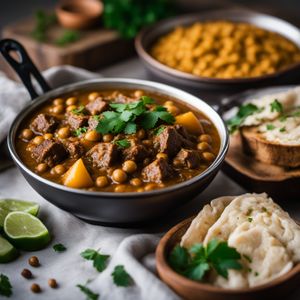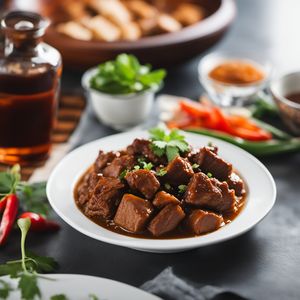
Dish
Carbonnade
Carbonnade is made with beef, onions, and beer, along with a variety of spices and seasonings. The dish is typically cooked for several hours to allow the flavors to meld together. It is often served with crusty bread or potatoes.
Origins and history
Carbonnade has its roots in the cuisine of Flanders, a region in northern Belgium. The dish has been enjoyed for centuries, and is often served at festivals and other special occasions.
Dietary considerations
Carbonnade is a high-protein dish that is also high in fat and calories. It is not recommended for those on a low-fat or low-calorie diet. It is also not suitable for vegetarians or vegans due to the use of meat and animal products.
Variations
There are many variations of Carbonnade, with different types of beer and spices used depending on the region and the cook's preferences. Some versions of the dish also include additional vegetables, such as carrots or mushrooms.
Presentation and garnishing
Carbonnade is typically served in a large pot, with the bread or potatoes served on the side. The dish can be garnished with fresh herbs or sliced vegetables for added color and flavor.
Tips & Tricks
To make Carbonnade, it is important to use high-quality beef and fresh onions. The dish should be cooked slowly over low heat to allow the flavors to develop fully. Leftovers can be stored in the refrigerator for several days and reheated as needed.
Side-dishes
Crusty bread or potatoes are the most common side dishes served with Carbonnade. Other options include roasted vegetables or a simple green salad.
Drink pairings
Carbonnade pairs well with a variety of drinks, including beer, wine, and cider. The rich, hearty flavors of the dish are complemented by the bitterness of the beer or the sweetness of the cider.
Delicious Carbonnade recipes
More dishes from this category... Browse all »

Aab gosht
Indian cuisine

Abgoosht
Iranian cuisine

Adobo
Filipino cuisine

Adobo sa gatâ
Filipino cuisine

Adobong baboy
Filipino cuisine

Adobong baka
Filipino cuisine

Adobong dilaw
Filipino cuisine

Adobong hito
Filipino cuisine
More cuisines from this region...

Dutch cuisine
Simple, Hearty, Savory, Creamy

French cuisine
Elegant, Sophisticated, Savory, Creamy

Luxembourgian cuisine
Hearty, Rich, Comforting, Flavorful, Savory

Monégasque cuisine
Fresh, Light, Flavorful, Mediterranean, Seafood-forward

Occitan cuisine
Hearty, Rustic, Flavorful, Savory, Comforting

